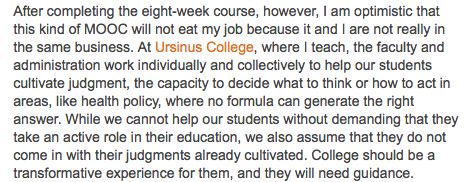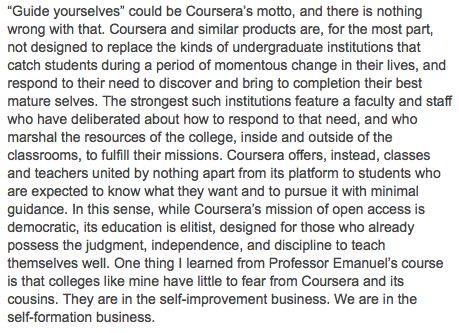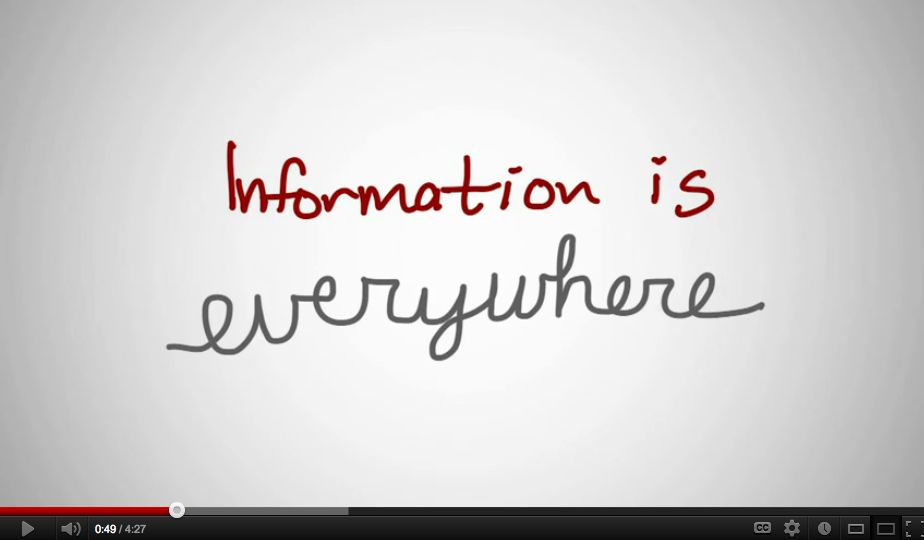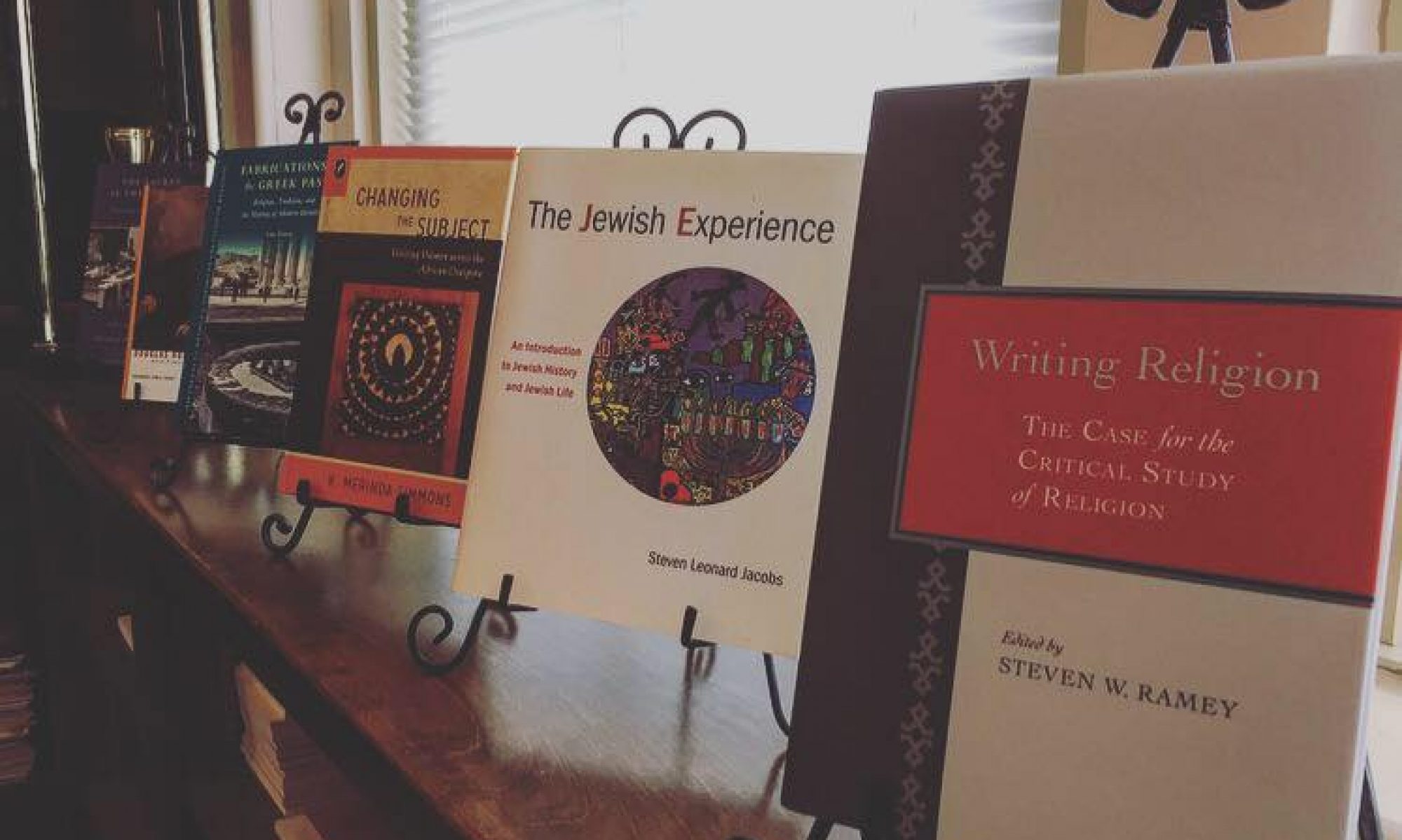 About a week ago, a friend at Ursinus College, in Pennsylvania, brought to my attention an online article written by his colleague in their Department of Politics and International Relations, about enrolling in a MOOC (massive open online course) to see what all the fuss was about. You may have heard about these courses–hosted by companies, such as Coursera, that have entered into agreements with schools, they provide the content for courses at some of the country’s leading universities–for free. (Fearing that they were behind this curve was among the apparent reasons why the University’s of Virginia’s Board of Visitors ousted–temporarily–their President this past summer.)
About a week ago, a friend at Ursinus College, in Pennsylvania, brought to my attention an online article written by his colleague in their Department of Politics and International Relations, about enrolling in a MOOC (massive open online course) to see what all the fuss was about. You may have heard about these courses–hosted by companies, such as Coursera, that have entered into agreements with schools, they provide the content for courses at some of the country’s leading universities–for free. (Fearing that they were behind this curve was among the apparent reasons why the University’s of Virginia’s Board of Visitors ousted–temporarily–their President this past summer.)
After initially being impressed by the course–specifically the knowledge and experience of the instructor, though certainly not with the insufficient interaction that the course provided–the author writes:
 This conclusion has something to do with another brief post that I just wrote, highlighting that what we do in the liberal arts is not just convey information; instead, we help students to learn how to learn. Whether or not people will wish to take free courses taught to thousands of people by impressively famous people, my hope is that they don’t fail to see that going to university, participating in a class, and moving through curriculum, is about more than just gaining specific information; education is not the sum total of the individual courses that you take.
This conclusion has something to do with another brief post that I just wrote, highlighting that what we do in the liberal arts is not just convey information; instead, we help students to learn how to learn. Whether or not people will wish to take free courses taught to thousands of people by impressively famous people, my hope is that they don’t fail to see that going to university, participating in a class, and moving through curriculum, is about more than just gaining specific information; education is not the sum total of the individual courses that you take.
Regardless how the growing for-profit online delivery industry tries to portray the supposed equivalence between their product and what I do in the classroom, a skilled lecturer is not simply a content provider. Instead, a good professor–and yes, of course, there are poor professors, as with any profession–presents to the students a model for: how to reason through an issue; how to speak with, listen to, and maybe even persuade people of differing views; how to deal with ambiguity and competing, even contradictory, information; and doing so on the spot, right in front of them and thus without a net beneath us, interrupted by a hand suddenly going up in the back of the room, someone’s eyebrows arced in surprised curiosity, or a student’s face scrunched up in puzzlement. Professors zero in on the winks and the nods in class–some are twitches, yeah, but others are clues and many are opportunities. While the important and ongoing need to provide engaging distance education options is crucial to address, and while technology (thankfully) takes us considerably further than those distance ed booklets that the U.S. Post used to carry back and forth between students and professors, good teachers do far more than talk to a camera, merely post PowerPoints online, or remain satisfied that, once it has been digitized (or “in the can,” as the old time filmmakers used to say), some past version of a lecture can live on as if in amber, as if it was the high point of their career.
So the article concludes:
 Which brings me back to that online video that I linked to above, when first mentioning MOOCs. What this video sales pitch–created by a University, if you can believe that–fails to recognize is that the thing that these courses are responding to and taking full advantage of (i.e., the digital access/information explosion) is actually the problem that these courses fail to help students grapple with.
Which brings me back to that online video that I linked to above, when first mentioning MOOCs. What this video sales pitch–created by a University, if you can believe that–fails to recognize is that the thing that these courses are responding to and taking full advantage of (i.e., the digital access/information explosion) is actually the problem that these courses fail to help students grapple with.
 Information is indeed everywhere, much as online courses and their providers soon will be, as will be the universities scrambling for their piece of this new revenue stream pie; perhaps the best way for students to address this over-abundance of information is not by passively watching isolated, authorized speakers on a computer screen but, instead, by speaking up for themselves as part of a group of people who you can wink and nod at, and who will wink and nod back at you.
Information is indeed everywhere, much as online courses and their providers soon will be, as will be the universities scrambling for their piece of this new revenue stream pie; perhaps the best way for students to address this over-abundance of information is not by passively watching isolated, authorized speakers on a computer screen but, instead, by speaking up for themselves as part of a group of people who you can wink and nod at, and who will wink and nod back at you.
The video ends (at about the 3:33 point) by selling viewers on the
 “… that they can easily maintain after the course finishes.” As I try to teach my students (who, in my experience, easily maintain what we used to just call “friendships” after the class is over–what university fundraisers long ago monetized as “alumni and donors”): show me the use of the word “authentic” and I’ll show you a sales pitch that’s more about rhetoric than substance and more about the interests of those selling the product and guarding their investment than those whom they’ve targeted to buy it.
“… that they can easily maintain after the course finishes.” As I try to teach my students (who, in my experience, easily maintain what we used to just call “friendships” after the class is over–what university fundraisers long ago monetized as “alumni and donors”): show me the use of the word “authentic” and I’ll show you a sales pitch that’s more about rhetoric than substance and more about the interests of those selling the product and guarding their investment than those whom they’ve targeted to buy it.
If it’s true for Oriental carpets or Mexican food or art or sacred relics, then what does it mean for the commodities that we call information and status? I wonder what my students would answer? I’ll ask them in person this week.
